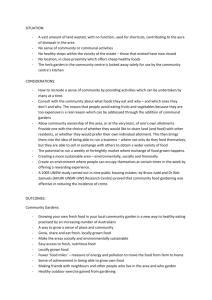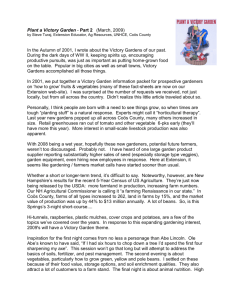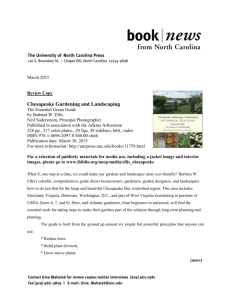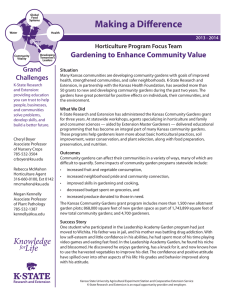Seattle’s P-Patch Community Gardens: Exploring Some Aspects of their Environmental Sustainability
advertisement
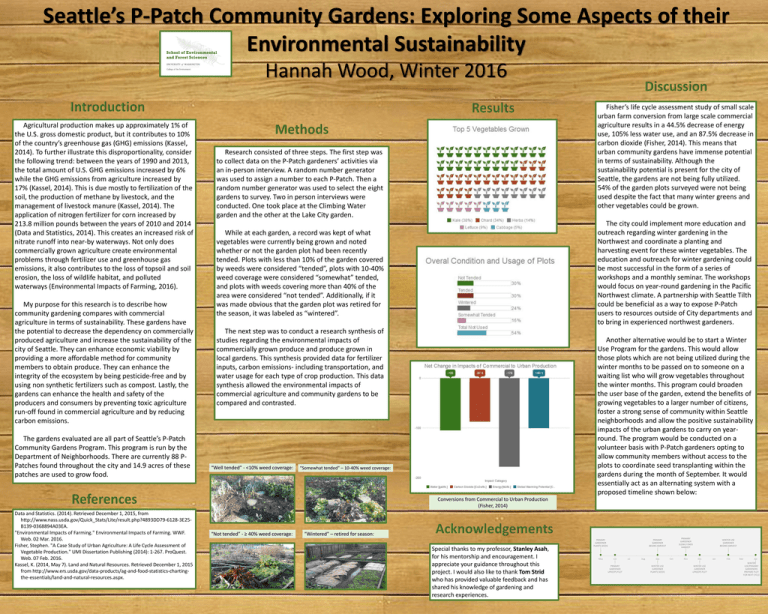
Seattle’s P-Patch Community Gardens: Exploring Some Aspects of their Environmental Sustainability Hannah Wood, Winter 2016 Agricultural production makes up approximately 1% of the U.S. gross domestic product, but it contributes to 10% of the country’s greenhouse gas (GHG) emissions (Kassel, 2014). To further illustrate this disproportionality, consider the following trend: between the years of 1990 and 2013, the total amount of U.S. GHG emissions increased by 6% while the GHG emissions from agriculture increased by 17% (Kassel, 2014). This is due mostly to fertilization of the soil, the production of methane by livestock, and the management of livestock manure (Kassel, 2014). The application of nitrogen fertilizer for corn increased by 213.8 million pounds between the years of 2010 and 2014 (Data and Statistics, 2014). This creates an increased risk of nitrate runoff into near-by waterways. Not only does commercially grown agriculture create environmental problems through fertilizer use and greenhouse gas emissions, it also contributes to the loss of topsoil and soil erosion, the loss of wildlife habitat, and polluted waterways (Environmental Impacts of Farming, 2016). My purpose for this research is to describe how community gardening compares with commercial agriculture in terms of sustainability. These gardens have the potential to decrease the dependency on commercially produced agriculture and increase the sustainability of the city of Seattle. They can enhance economic viability by providing a more affordable method for community members to obtain produce. They can enhance the integrity of the ecosystem by being pesticide-free and by using non synthetic fertilizers such as compost. Lastly, the gardens can enhance the health and safety of the producers and consumers by preventing toxic agriculture run-off found in commercial agriculture and by reducing carbon emissions. The gardens evaluated are all part of Seattle’s P-Patch Community Gardens Program. This program is run by the Department of Neighborhoods. There are currently 88 PPatches found throughout the city and 14.9 acres of these patches are used to grow food. Fisher’s life cycle assessment study of small scale urban farm conversion from large scale commercial agriculture results in a 44.5% decrease of energy use, 105% less water use, and an 87.5% decrease in carbon dioxide (Fisher, 2014). This means that urban community gardens have immense potential in terms of sustainability. Although the sustainability potential is present for the city of Seattle, the gardens are not being fully utilized. 54% of the garden plots surveyed were not being used despite the fact that many winter greens and other vegetables could be grown. Research consisted of three steps. The first step was to collect data on the P-Patch gardeners’ activities via an in-person interview. A random number generator was used to assign a number to each P-Patch. Then a random number generator was used to select the eight gardens to survey. Two in person interviews were conducted. One took place at the Climbing Water garden and the other at the Lake City garden. The city could implement more education and outreach regarding winter gardening in the Northwest and coordinate a planting and harvesting event for these winter vegetables. The education and outreach for winter gardening could be most successful in the form of a series of workshops and a monthly seminar. The workshops would focus on year-round gardening in the Pacific Northwest climate. A partnership with Seattle Tilth could be beneficial as a way to expose P-Patch users to resources outside of City departments and to bring in experienced northwest gardeners. While at each garden, a record was kept of what vegetables were currently being grown and noted whether or not the garden plot had been recently tended. Plots with less than 10% of the garden covered by weeds were considered “tended”, plots with 10-40% weed coverage were considered “somewhat” tended, and plots with weeds covering more than 40% of the area were considered “not tended”. Additionally, if it was made obvious that the garden plot was retired for the season, it was labeled as “wintered”. The next step was to conduct a research synthesis of studies regarding the environmental impacts of commercially grown produce and produce grown in local gardens. This synthesis provided data for fertilizer inputs, carbon emissions- including transportation, and water usage for each type of crop production. This data synthesis allowed the environmental impacts of commercial agriculture and community gardens to be compared and contrasted. “Well tended” - <10% weed coverage: Another alternative would be to start a Winter Use Program for the gardens. This would allow those plots which are not being utilized during the winter months to be passed on to someone on a waiting list who will grow vegetables throughout the winter months. This program could broaden the user base of the garden, extend the benefits of growing vegetables to a larger number of citizens, foster a strong sense of community within Seattle neighborhoods and allow the positive sustainability impacts of the urban gardens to carry on yearround. The program would be conducted on a volunteer basis with P-Patch gardeners opting to allow community members without access to the plots to coordinate seed transplanting within the gardens during the month of September. It would essentially act as an alternating system with a proposed timeline shown below: “Somewhat tended” – 10-40% weed coverage: Conversions from Commercial to Urban Production (Fisher, 2014) Data and Statistics. (2014). Retrieved December 1, 2015, from http://www.nass.usda.gov/Quick_Stats/Lite/result.php?4893DD79-6128-3E25B139-0368894A03EA. "Environmental Impacts of Farming." Environmental Impacts of Farming. WWF. Web. 02 Mar. 2016. Fisher, Stephen. "A Case Study of Urban Agriculture: A Life Cycle Assessment of Vegetable Production." UMI Dissertation Publishing (2014): 1-267. ProQuest. Web. 07 Feb. 2016. Kassel, K. (2014, May 7). Land and Natural Resources. Retrieved December 1, 2015 from http://www.ers.usda.gov/data-products/ag-and-food-statistics-chartingthe-essentials/land-and-natural-resources.aspx. “Not tended” - ≥ 40% weed coverage: “Wintered” – retired for season: Special thanks to my professor, Stanley Asah, for his mentorship and encouragement. I appreciate your guidance throughout this project. I would also like to thank Tom Strid who has provided valuable feedback and has shared his knowledge of gardening and research experiences. PRIMARY GARDENER PLANTS SEEDS May PRIMARY GARDENER SLOWLY ENDS HARVEST PRIMARY GARDENER BEGINS HARVEST Jun PRIMARY GARDENER UPKEEPS PLOT Jul Aug Sep WINTER USE GARDENER PLANTS SEEDS Oct Nov WINTER USE GARDENER BEGINS HARVEST Dec WINTER USE GARDENER UPKEEPS PLOT Jan Feb Mar Apr WINTER USE/PRIMARY GARDENERS PREPARE PLOT FOR NEXT CYCLE
